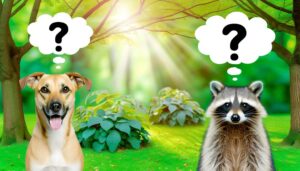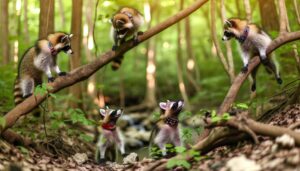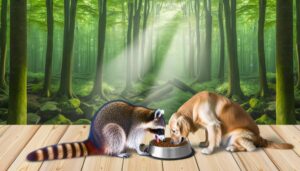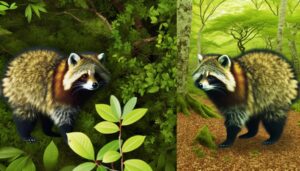How Does Raccoon Poop Look Like Dog Poop?
Raccoon waste possess distinct characteristics different from dog poop. Unlike dog waste whose appearance can vary, raccoon droppings are uniformly dark, tube-shaped, and approximately 2-3 inches in length.
Additionally, undigested food particles are often visible in raccoon waste. These variations assist in distinguishing between the two.
Recognizing these differences is essential due to the potential health risks, including Baylisascaris procyonis and Salmonella, associated with raccoon waste. For detailed information covering raccoon behaviors, waste identification, associated health risks, and subsequent handling protocols, one should proceed further into the subject.
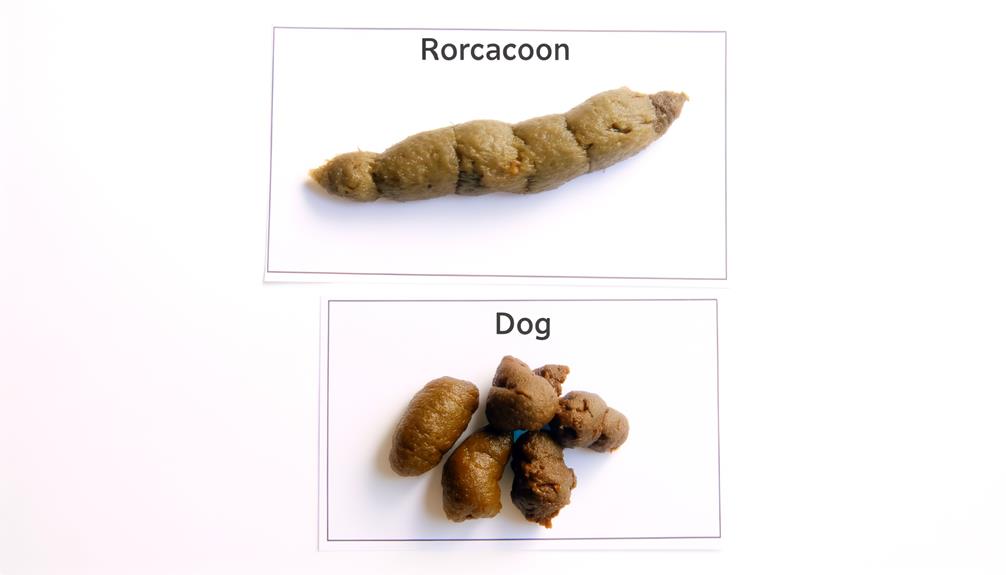
Key Takeaways
- Raccoon feces are typically dark, tubular, and 2-3 inches long, often containing undigested food particles.
- Dog feces can significantly vary in color, consistency, size, and shape, reflecting the animal's overall health status.
- The health risks associated with raccoon feces include Baylisascaris procyonis, Leptospirosis, Giardiasis, Rabies, and Salmonella.
- Regular pet waste cleanup helps differentiate between raccoon droppings and dog poop, reducing disease transmission and environmental pollution.
- Proper handling of wildlife feces, like raccoon droppings, involves using personal protective equipment and professional removal services.
Understanding Raccoon Behaviors
To fully comprehend the appearance of raccoon feces, it is imperative to first explore their distinctive behaviors and dietary patterns. Raccoons are omnivores, consuming a diverse diet that includes fruits, plants, insects, nuts, fish, and smaller mammals. Their food intake varies depending on their habitat and the season.
Raccoons are known for their unique behavior of washing their food before eating, although this is not directly linked to their fecal appearance. Besides, raccoons are nocturnal creatures, typically feeding at night, which affects their defecation patterns. Their lifestyle of scavenging in urban areas means they often consume human food waste, which can alter the physical properties of their feces.
Understanding these behaviors provides a foundation for distinguishing raccoon droppings.
Identifying Raccoon Droppings
Identifying raccoon droppings involves a careful examination of their physical characteristics and understanding the potential health risks associated with them.
Primary focus should be on the appearance, size, and shape of the droppings, as these are distinguishing factors that separate them from other animal feces.
Additionally, it is imperative to take into account the associated health risks, given the presence of harmful parasites and diseases in raccoon excrement.
Raccoon Droppings Appearance
Understanding the appearance of raccoon droppings is crucial in distinguishing them from other animal feces, such as those of dogs. Characteristically, raccoon feces possess a distinct, recognizable texture and color.
The texture is often fragmented and loose, due to the raccoon's varied diet which includes fruits, nuts, seeds, and a variety of meats. The droppings usually display a dark, tubular shape with blunt ends.
Regarding color, raccoon feces are generally a deep black or brown, often with a shiny, damp appearance when fresh, which over time, fades to a dull, lighter hue. Importantly, undigested food particles are typically visible, providing additional clues to the origin of the feces.
Size and Shape Differences
In examining the size and shape of raccoon droppings, one can find marked differences when compared to other animals such as dogs. Raccoon droppings are typically cylindrical and measure about two to three inches in length, often resembling those of a small dog. However, there are distinct characteristics:
- Raccoon scat often contains undigested food particles, which is not common in dog poop.
- The ends of raccoon droppings are typically blunt or have a slight point.
- They often have a strong, unpleasant odor distinct from dog excrement.
- Raccoon droppings are usually darker in color, often black, brown, or green.
- They may be found in piles, a behavior not observed in dogs.
These peculiarities aid in differentiating raccoon feces from that of dogs, fostering a more accurate identification.
Health Risks Involved
While differentiating raccoon feces from that of dogs can be insightful for numerous reasons, one paramount consideration revolves around the potential health risks associated with raccoon droppings. These feces can harbor infectious diseases such as Baylisascaris procyonis, a harmful roundworm, which can potentially cause severe neurological disorders in humans upon accidental ingestion or inhalation of eggs present in the feces.
Other diseases like Leptospirosis and Salmonella can also be contracted through contact with raccoon excrement. Identifying raccoon droppings and implementing necessary precautions is thus not only a matter of public health but a requisite for personal freedom from health risks.
Understanding the characteristics of raccoon droppings, hence, becomes paramount in ensuring a safe and disease-free environment.
Dog Poop Characteristics
To understand if raccoon feces can be mistaken for dog feces, it is essential to first understand the characteristics of canine excrement. This involves examining factors such as its color and consistency, size and shape, as well as odor and potential health indicators.
Each of these elements can provide valuable insights into not only the animal's species, but also its diet and overall health status.
Color and Consistency
Analyzing the color and consistency of dog feces provides valuable insight into the animal's health and diet. Feces that are brown and firm in consistency generally indicate a healthy diet and no significant health issues.
However, variations can reveal potential problems. To understand better, let's highlight some of the color variations and what they might signify:
- Yellow or green feces may indicate gastrointestinal issues.
- Black or dark-colored feces can suggest internal bleeding.
- Grey or clay-colored feces might mean problems with the liver or bile duct.
- Bright red streaks could imply bleeding in the lower digestive tract.
- Consistently soft or liquid feces can point towards dietary issues or illnesses.
These are general guidelines and seeing a vet is always recommended for any concerns.
Size and Shape
Moving on to size and shape, these aspects of dog feces can also provide significant insights into the animal's health condition.
In general, the size of the stool should be proportionate to the size of the dog. Larger breeds will naturally produce larger feces, while smaller breeds will produce smaller feces. Anomalies in size may indicate a change in diet, or possible health issues such as gastrointestinal disorders.
The shape of dog feces typically appears cylindrical, often segmented due to the formation and expulsion process within the colon. An irregular shape or presence of mucus may signal intestinal problems.
In comparing it with raccoon feces, the latter is also cylindrical but often contains undigested food particles, distinguishing it from canine feces.
Odor and Health Indicators
Delving into the characteristics of odor and health indicators in dog feces, we find that a distinct smell is often present, serving as a significant clue about the animal's health status.
Numerous factors can affect the smell, color, and consistency of dog feces, including:
- Diet: Higher quality food typically results in less smelly, firm, and darker stool.
- Health conditions: Diseases like pancreatitis, intestinal infections, and parasites can cause foul-smelling, loose, or unusually colored feces.
- Medications: Certain drugs can alter stool characteristics.
- Hydration: Dehydration can lead to harder, smaller, and potentially more smelly feces.
- Stress: Can result in diarrhea, which may smell worse than usual.
These factors contribute to the overall health profile of a dog, as indicated by its feces.
Comparing Raccoon and Dog Poop
In a detailed comparison of raccoon and dog feces, it is of particular importance to note the distinct differences in size, shape, color, and content.
Raccoon feces typically measure between two and three inches in length and have a tube-like structure, whereas dog feces can vary considerably depending on the size and diet of the dog.
The color of raccoon feces is usually dark, owing to their omnivorous diet, while dog feces can range from light to dark brown.
Raccoon feces often contain undigested food particles, particularly berries or seeds, which is less common in dog feces.
Further, raccoon feces tend to be more aromatic due to their varied diet.
These differences are crucial in distinguishing between raccoon and dog feces, an essential step in pest identification.
Health Risks Associated With Raccoon Poop
While the physical characteristics of raccoon feces are essential for identification, it is equally important to understand the potential health risks they pose.
Raccoon feces are known carriers of numerous pathogens and parasites that can cause significant harm to humans and pets.
- Baylisascaris procyonis: A roundworm that can cause severe neurological problems.
- Leptospirosis: A bacterial infection that can lead to kidney damage, meningitis, liver failure, and respiratory distress.
- Giardiasis: An intestinal infection causing diarrhea, gas, stomach cramps, nausea, and dehydration.
- Rabies: A deadly virus that affects the nervous system, leading to brain disease and death.
- Salmonella: A bacterial infection causing diarrhea, fever, and abdominal cramps.
Understanding these risks is essential for maintaining health and ensuring the freedom to enjoy outdoor spaces without fear.
Proper Handling of Wildlife Feces
Given the significant health risks associated with raccoon feces, it is important to employ safe and effective methods when handling any wildlife excrement.
Proper handling includes use of personal protective equipment (PPE) such as gloves, masks, and eye protection. The feces should be collected with a plastic bag or shovel, avoiding direct contact.
It is vital not to stir up dust by sweeping or vacuuming, as this can aerosolize the harmful pathogens. Once collected, the feces should be double-bagged and disposed of in a secure trash receptacle.
Hand hygiene is pivotal after handling, even with PPE. Use soap and warm water for at least 20 seconds. Never attempt to compost or burn wildlife feces, as this can release harmful pathogens into the environment.
Methods of Raccoon Deterrence
To further minimize the health risks associated with raccoon feces, it is beneficial to implement strategies aimed at deterring these mammals from inhabiting your property.
There are scientifically-proven methods that can be employed to discourage raccoon habitation:
- Securing trash cans with lockable lids to restrict the raccoon's access to potential food sources.
- Installing motion-activated sprinklers or lights, which can startle and deter raccoons.
- Using commercial raccoon repellents, which create an environment that raccoons find disagreeable.
- Pruning tree branches that provide easy access to rooftops, as raccoons are excellent climbers.
- Sealing off potential denning sites such as sheds, decks, and crawl spaces.
These methods uphold your freedom to maintain a raccoon-free environment while ensuring the safety and health of the ecosystem.
Professional Raccoon Removal Services
In the event of a persistent raccoon infestation, professional raccoon removal services offer an effective solution, employing specialized techniques and equipment to safely and humanely remove these critters from residential or commercial properties.
These professionals are trained in identifying raccoon nesting sites, behavior patterns, and points of entry into a building. They use a combination of exclusion strategies, live trapping, and relocation methods that adhere to local wildlife regulations.
Additionally, these services often include decontamination to eliminate any potential health risks associated with raccoon feces or urine.
Essentially, by engaging professional raccoon removal services, property owners can regain their freedom from this nuisance wildlife, ensuring a safe and peaceful environment.
Importance of Regular Pet Waste Cleanup
Regular cleaning and disposal of pet waste, particularly in outdoor spaces, is a critical practice in maintaining public health and environmental integrity. The benefits of such practice are numerous:
- It prevents the transmission of diseases to other animals and humans.
- Proper waste management reduces environmental pollution.
- It helps in controlling pests such as flies and rats that are attracted to pet waste.
- Regular cleanup maintains the aesthetic appeal of the surroundings.
- It fosters responsible pet ownership and respect for public spaces.
Conclusion
To sum up, differentiating between raccoon and dog feces is vital due to the associated health risks. Regular pet waste cleanup and professional raccoon removal services are essential preventative measures.
As the saying goes, 'an ounce of prevention is worth a pound of cure.' Understanding wildlife behavior and identifying fecal matter appropriately can notably reduce potential hazards, supporting a safer coexistence between urban wildlife and humans.

